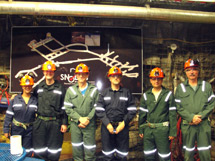
Handy Links
SLAC News Center
SLAC Today
- Subscribe
- Archives: Feb 2006-May 20, 2011
- Archives: May 23, 2011 and later
- Submit Feedback or Story Ideas
- About SLAC Today
SLAC News
Lab News
- Interactions
- Lightsources.org
- ILC NewsLine
- Int'l Science Grid This Week
- Fermilab Today
- Berkeley Lab News
- @brookhaven TODAY
- DOE Pulse
- CERN Courier
- DESY inForm
- US / LHC
SLAC Links
- Emergency
- Safety
- Policy Repository
- Site Entry Form

- Site Maps
- M & O Review
- Computing Status & Calendar
- SLAC Colloquium
- SLACspeak
- SLACspace
- SLAC Logo
- Café Menu
- Flea Market
- Web E-mail
- Marguerite Shuttle
- Discount Commuter Passes
-
Award Reporting Form
- SPIRES
- SciDoc
- Activity Groups
- Library
Stanford
Around the Bay
SuperCDMS Analysis Workshop Starts Today
More than thirty members of the Super Cryogenic Dark Matter Search collaboration from 12 different institutions descend on SLAC today for four days of workshops meant to bring new team members up to speed on data analysis methods used in the project's search for dark matter. While researchers from the Kavli Institute for Particle Astrophysics and Cosmology have been a part of the collaboration for several years, the SLAC team, led by Eduardo do Couto e Silva, officially joined the collaboration only last year.
The SLAC group is organizing the workshop in collaboration with the SuperCDMS group at Stanford University lead by Professor Blas Cabrera. Mornings will include informational talks, while afternoons will include hands-on training. Team members will also have ample opportunity for less formal discussions. "We're trying not to pack the agenda too much," said Anders Borgland, leader of the SLAC SuperCDMS Software and Computing group. He's reserved space for workshop attendees who "want to just talk."
According to Borgland, the meeting is also an opportunity for the new team members from SLAC to introduce themselves and what they have to offer: in addition to working on fabricating the crystals of pure germanium that will be used as the dark matter detector, SLAC physicists and software developers are creating specialized software and providing computing infrastructure to aid in data analysis.
The SuperCDMS project is essentially a ramp up of the CDMS and CDMS II projects, using ever larger and more sensitive detectors and better shielding. Currently SLAC physicists and software developers are learning how to tell the difference between detector signals caused by dark matter particles banging into the nuclei of germanium molecules, and detector signals caused by a myriad other possibilities, such as gamma rays and cosmic rays. The SLACers will turn this knowledge into what are called Monte Carlo simulations, which will help during the actual experiment by enabling the team to separate the WIMPs (weakly interacting massive particles, aka dark matter) from the chaff.
But it's still early days for SLAC in the SuperCDMS project. "We're still a bit in the presentation phase," Borgland said. The software won't officially roll out until 2014, when the SuperCDMS at SNOLAB experiment is expected to kick off in an underground laboratory situated 6800 feet below the surface in an active nickel mine.
In addition, Borgland hopes to be able to provide some software to the current CDMS project, SuperCDMS at Soudan, the underground laboratory where the CDMS II experiment took place. This will give team members an opportunity to extensively test and debug the software prior to its rollout in SNOLAB.
This week may be an opportunity for SLAC collaboration members to introduce themselves to the rest of the collaboration, but several new SuperCDMS team members from SLAC recently received their own introduction to SuperCDMS when they travelled to Sudbury, Ontario, for a SuperCDMS Collaboration meeting which included a trip to SNOLAB.
"To get there you take the elevator—what they call the cage–down, dropping 2000 feet per minute," Borgland said. "Literally your ears are popping. It's just like being on an airplane. Then you walk for about 20 to 25 minutes in full mining gear. Then you get to SNOLAB, which is actually one giant clean room."
The SuperCDMS collaboration thinks SNOLAB sounds like a good place to look for the answer to one of the big mysteries of physics.
Borgland thinks it's something else. "Kind of amazing," he said.
—Lori Ann White
SLAC Today, September 7, 2010
